
Top Project Management Planner for 2025 | Organize Your Tasks
Share
Unlocking Productivity with the Right Project Management Planner
Overwhelmed by deadlines and to-do lists? A project management planner is crucial for staying organized and achieving your goals. This listicle presents eight top-tier project management planners, ranging from physical planners to robust digital platforms, to help you conquer your projects. Discover which project management planner best fits your needs, whether you're an entrepreneur, teacher, student, or business professional, and reclaim control of your time. We'll cover Boss Personal Planner, Asana, Microsoft Project, Trello, Monday.com, Jira, ClickUp, and Passion Planner.
1. Boss Personal Planner
The Boss Personal Planner distinguishes itself as a comprehensive project management planner, effectively bridging the gap between digital and physical planning. This versatile system is scientifically designed to enhance productivity by streamlining goal setting, task management, and schedule organization. Whether you're an entrepreneur juggling multiple ventures, a teacher managing lesson plans and grading, a student balancing coursework and extracurriculars, or a business professional striving to meet deadlines, the Boss Personal Planner offers a tailored approach to project management. It helps transform overwhelming to-do lists into clear, actionable plans, facilitating a seamless integration of daily tasks with long-term projects. This approach ensures that your daily actions contribute to your overarching goals, promoting sustained progress and a sense of accomplishment.
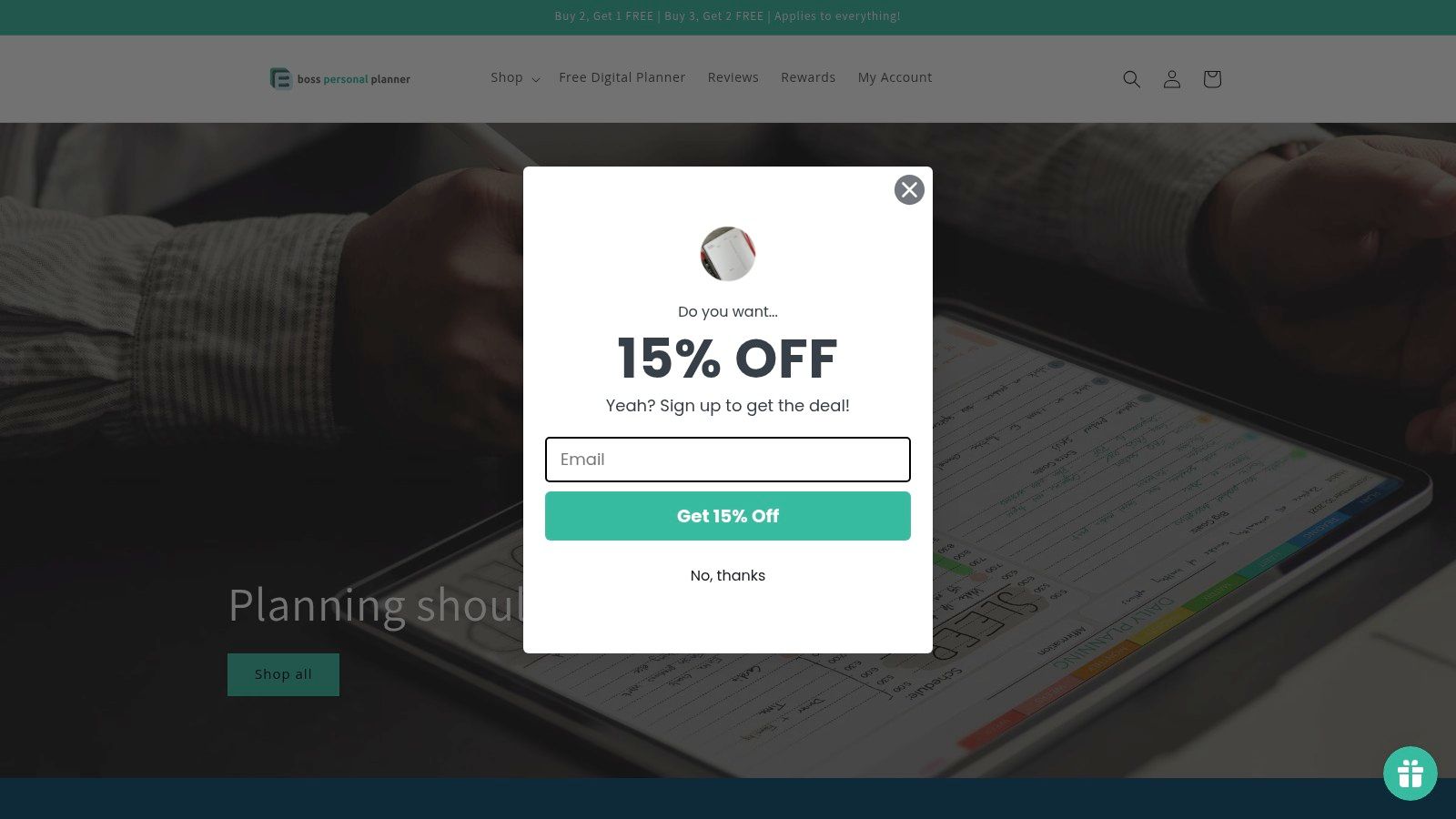
The Boss Personal Planner offers a variety of formats to suit individual preferences, including printable PDFs, physical notebooks, and digital templates compatible with platforms like Notion. This flexibility allows you to choose the format that best complements your workflow and technical comfort level. For example, if you prefer the tactile experience of pen and paper, the physical notebooks provide a dedicated space for planning and reflection. If you thrive in a digital environment, the digital templates offer seamless integration with your existing tools. Learn more about Boss Personal Planner for specific use cases and examples of how the planner can be adapted to various needs.
One of the key strengths of the Boss Personal Planner is its user-friendly layout. The system cleverly integrates daily tasks with long-term project management, providing a holistic view of your commitments and ensuring that your daily efforts align with your larger objectives. This integration eliminates the need for separate tools and simplifies the process of tracking progress toward your goals. The scientifically-backed productivity methods employed by the planner help optimize goal achievement, empowering users to stay focused and motivated.
While the Boss Personal Planner offers extensive features, it’s important to be aware of its limitations. While the digital templates offer robust functionality, some, particularly those designed for Notion, may require a degree of familiarity with the platform for optimal use. Additionally, the physical planners, while well-designed, offer limited advanced customization compared to some highly specialized planners on the market. However, the Boss Personal Planner's core strength lies in its streamlined, accessible approach, making it an ideal choice for those seeking a practical and effective project management solution.
The Boss Personal Planner offers exceptional value, with budget-friendly pricing and frequent promotions, such as "Buy 2, Get 1 FREE" deals and substantial discounts on bundles. Visit the Boss Personal Planner website to explore the different options and find the perfect fit for your project management needs. Its comprehensive features, flexible formats, and affordable pricing make it a compelling option for anyone seeking a powerful tool to enhance productivity and achieve their goals.
2. Asana: Your All-in-One Project Management Planner
Asana is a powerful and versatile project management planner suitable for individuals and teams of all sizes. Whether you're an entrepreneur managing a startup, a teacher coordinating lesson plans, a student juggling multiple projects, or a business professional overseeing complex initiatives, Asana provides the tools you need to stay organized and achieve your goals. Its comprehensive features and flexible views – including lists, boards, timelines, and calendars – allow you to tailor your project management approach to fit your specific needs and preferred methodologies. From simple task management to complex project workflows, Asana can be a game-changer for anyone looking to improve their productivity and project outcomes. Asana allows for real-time progress tracking, streamlined communication, and efficient task allocation, making it a valuable asset for achieving project success.
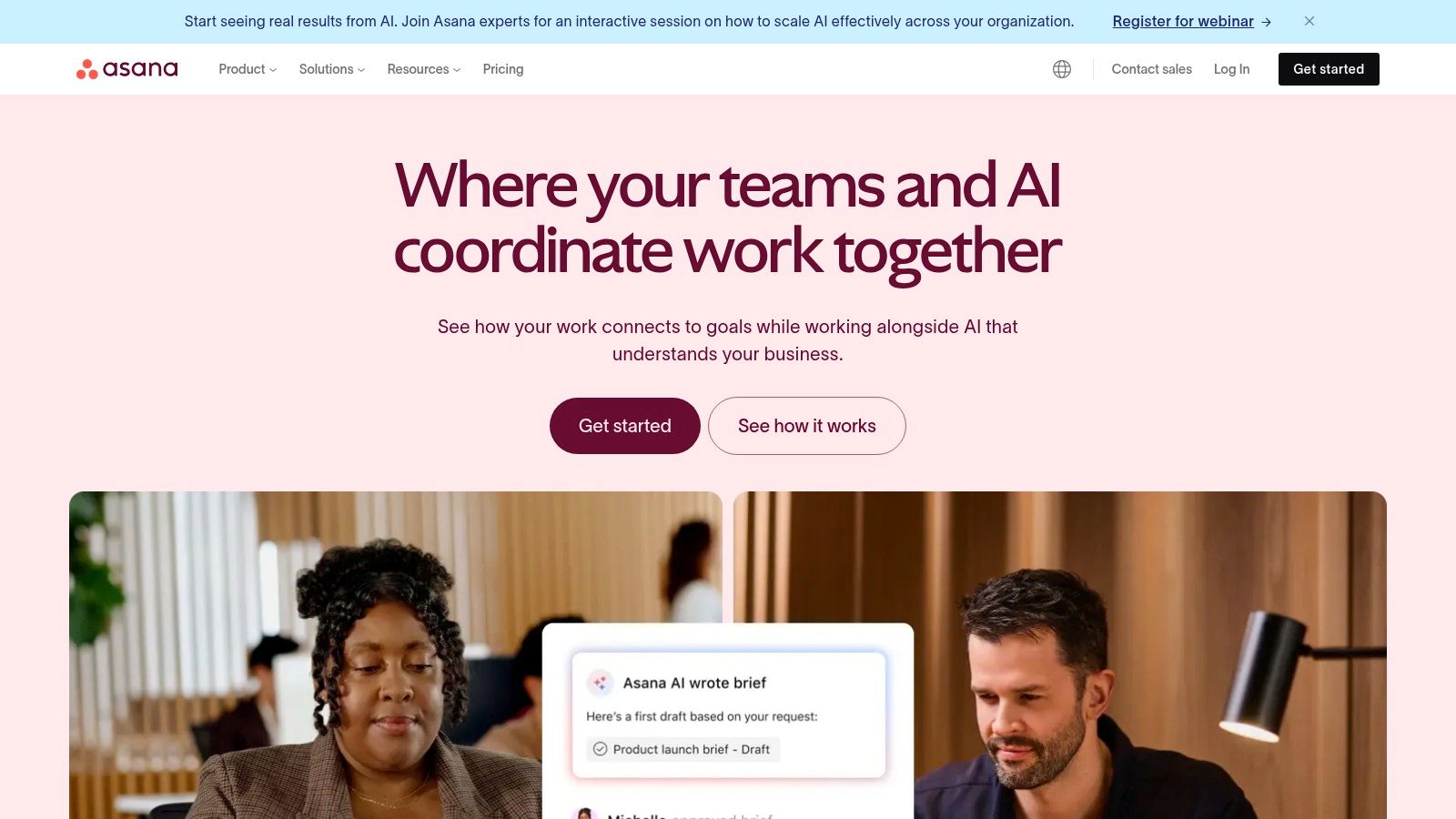
Key Features and Benefits:
Asana's robust feature set empowers teams to manage every aspect of their projects within a single platform. Here are some of the standout features:
- Task Management: Create tasks, assign them to team members, set due dates, add custom fields for specific information (e.g., priority, status), and attach relevant files. This granular control ensures everyone knows their responsibilities and deadlines.
- Timeline View: Visualize your project schedule with a Gantt chart-style timeline. This feature is invaluable for identifying dependencies, tracking milestones, and managing complex projects with interconnected tasks.
- Workflow Automation: Automate repetitive tasks, such as assigning tasks based on completion of previous steps or sending notifications upon task completion. This automation saves time and reduces the risk of human error.
- Cross-Functional Project Views: Choose the view that best suits your project and team. Kanban boards provide a visual workflow overview, lists offer a simple and structured approach, and calendars highlight deadlines and schedules.
- Integrations: Connect Asana with over 200 other business applications, such as Slack, Google Calendar, and Microsoft Teams. This seamless integration streamlines workflows and centralizes information.
Pros:
- Intuitive Interface: Asana’s user-friendly interface is easy to navigate, requiring minimal training for new users.
- Customization: Highly customizable to fit various team structures, project types, and workflow preferences.
- Generous Free Tier: A robust free plan caters to teams of up to 15 members, making it an excellent option for smaller teams or individuals.
- Mobile Apps: Powerful mobile apps for iOS and Android allow for on-the-go project management and collaboration.
Cons:
- Pricing for Larger Teams: While the free tier is generous, pricing can become substantial for larger teams requiring more advanced features.
- Feature Overload: The extensive feature set can feel overwhelming for simple projects or users new to project management software.
- Learning Curve for Advanced Features: Mastering advanced features like workflow automation requires some dedicated learning and experimentation.
- Limited Reporting: Reporting capabilities are somewhat limited in the lower-tier plans.
Pricing: Asana offers a free plan, as well as paid plans with increasing features and user capacity. Check their website for current pricing details.
Technical Requirements: Asana is web-based and accessible from any modern browser. Mobile apps are available for iOS and Android devices.
Why Asana Deserves Its Place:
Asana earns its spot on this list due to its comprehensive feature set, flexible views, user-friendly interface, and generous free tier. Its ability to adapt to various project management styles and team sizes makes it a versatile choice for a wide range of users, from students to enterprise-level organizations. While it may not be the perfect fit for every project, Asana's power and adaptability make it a top contender in the project management planner space.
Getting Started with Asana:
- Start Small: Begin with a simple project and gradually explore more advanced features as you become comfortable.
- Utilize Templates: Asana offers pre-built templates for various project types, which can save you time and effort in setting up your projects.
- Explore Integrations: Connect Asana with the tools your team already uses to maximize efficiency.
Website: https://asana.com
3. Microsoft Project: Robust Project Management for Complex Endeavors
Microsoft Project is a powerful project management planner designed for handling complex, resource-intensive projects. As an industry standard, it's widely used by business professionals in various sectors, from engineering and construction to IT and marketing. While it may be overkill for simple projects, its robust features make it a top contender for managing intricate initiatives. This software helps project managers develop detailed plans, allocate resources effectively, track progress meticulously, manage budgets accurately, and analyze workloads efficiently. Whether you're an entrepreneur launching a new product, a teacher coordinating a complex school event, a student managing a demanding research project, or a business professional overseeing a large team, understanding Microsoft Project's capabilities can significantly elevate your project management skills.
Why Microsoft Project Deserves Its Place on This List:
For intricate projects requiring meticulous planning and resource allocation, Microsoft Project stands out. Its advanced scheduling, robust resource management, and detailed reporting capabilities provide project managers with the tools they need to succeed. While other simpler project management planners may suffice for basic tasks, Microsoft Project excels in handling complexity and providing in-depth analysis. Its integration with the Microsoft 365 ecosystem further enhances its value for businesses already utilizing that platform.
Key Features and Benefits:
- Advanced Scheduling: Microsoft Project's strength lies in its sophisticated scheduling engine. It allows for detailed task dependencies, critical path analysis, and Gantt chart visualization, empowering project managers to plan and control project timelines precisely. This is particularly beneficial for projects where task dependencies are complex and critical deadlines must be met.
- Resource Management and Capacity Planning: The software provides comprehensive resource allocation and leveling capabilities. Project managers can assign resources to tasks, track their availability, and optimize resource utilization to avoid overloads and delays. This feature is crucial for managing projects with multiple team members and limited resources.
- Multiple Project Management and Resource Pool Sharing: For organizations managing multiple projects simultaneously, Microsoft Project enables resource pool sharing and portfolio management. This allows for efficient allocation of resources across different projects and optimizes resource utilization across the entire portfolio.
- Seamless Integration with Microsoft 365: Microsoft Project integrates smoothly with other Microsoft 365 applications, such as Excel, SharePoint, and Teams. This integration facilitates data sharing, collaboration, and reporting, streamlining workflows and enhancing team communication.
Pros:
- Powerful for Complex Projects: Ideal for large-scale projects with intricate dependencies and resource requirements.
- Comprehensive Resource Allocation: Provides advanced tools for resource leveling and optimization.
- Industry Standard: Widely recognized and used, making it a valuable skill for project managers.
- Robust Reporting: Offers in-depth reporting tools for executive insights and data-driven decision-making.
Cons:
- Steep Learning Curve: Requires dedicated training to master its advanced features.
- Higher Price Point: Compared to other project management planner software, Microsoft Project is a more significant investment.
- Overly Complex for Simple Projects: Can be overkill for small projects with basic requirements.
- Limited Collaboration in Desktop Version: While integration with Microsoft 365 enhances collaboration, the desktop version has some limitations.
Pricing and Technical Requirements:
Microsoft Project offers various plans based on cloud-based or on-premise deployment, with pricing varying accordingly. Check the Microsoft website for the most up-to-date pricing information. Technical requirements will also depend on the chosen plan.
Implementation Tips:
- Start with Training: Invest in comprehensive training to effectively utilize the software's capabilities.
- Begin with a Simple Project: Don't jump into a complex project right away. Start with a smaller project to familiarize yourself with the software's features.
- Utilize Templates: Microsoft Project offers pre-built templates that can significantly speed up the project setup process.
- Integrate with Existing Tools: Leverage the integration with Microsoft 365 to streamline workflows and enhance collaboration.
Website: https://www.microsoft.com/en-us/microsoft-365/project/project-management-software
4. Trello: A Visual Project Management Planner
Trello stands out as a highly effective project management planner, especially for those who thrive in a visual environment. Its Kanban-style approach utilizes boards, lists, and cards to represent projects, tasks, and their respective stages. This intuitive system makes it easy to track progress at a glance, making it an excellent choice for individuals and teams seeking a streamlined, visual workflow. Whether you're managing a marketing campaign, coordinating a classroom project, or organizing your personal to-dos, Trello offers a flexible framework adaptable to various project types.
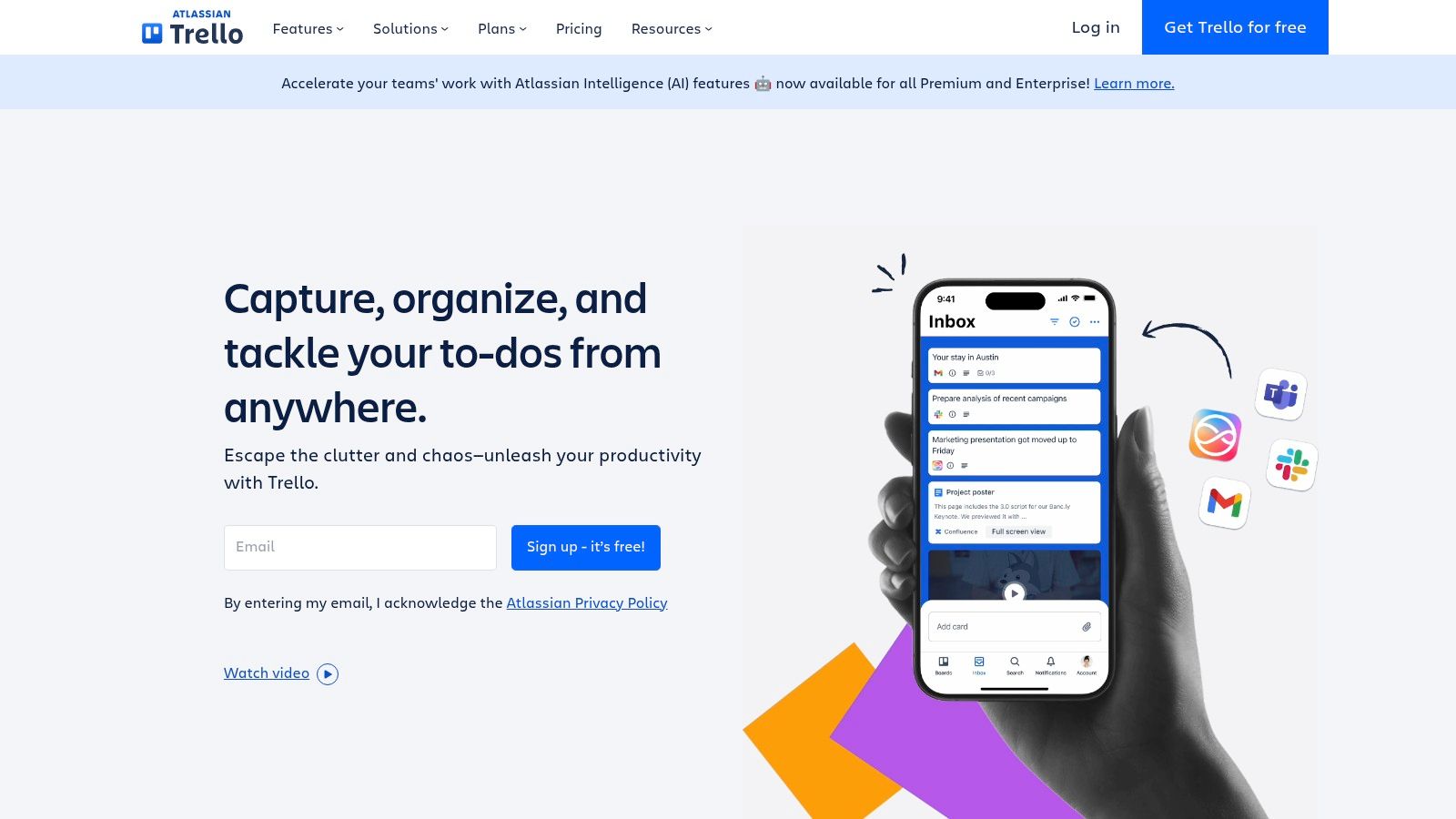
Trello’s core strength lies in its simplicity and visual clarity. Imagine managing a website redesign project. You could create a Trello board titled "Website Redesign," with lists such as "To Do," "In Progress," and "Completed." Within each list, individual tasks (e.g., "Write website copy," "Design homepage mockup," "Implement new SEO strategy") are represented as cards. As tasks progress, team members can simply drag and drop cards from one list to another, providing a real-time visual representation of the project's status.
Trello's features extend beyond basic Kanban boards. Power-Ups integrate additional functionalities, such as calendars for deadlines, automation tools like Butler for repetitive tasks, and integrations with other applications. Cards can be enriched with checklists, due dates, labels, and attachments, ensuring all relevant information is readily accessible. Collaboration is facilitated through comments and activity tracking, allowing team members to communicate effectively and stay updated on progress.
Pricing and Technical Requirements: Trello offers a generous free plan, making it accessible to individuals and small teams. Paid plans unlock additional features like unlimited boards, advanced checklists, and custom fields. Trello is a web-based application accessible from any browser and also offers mobile apps for iOS and Android devices.
Comparison with Similar Tools: While tools like Asana and Monday.com offer more robust features for complex projects, Trello excels in its simplicity and ease of use. For individuals, students, teachers, and small teams managing relatively straightforward projects, Trello's intuitive interface provides a less daunting entry point into project management compared to more feature-rich alternatives.
Implementation and Setup Tips: Getting started with Trello is straightforward. Create a board, define your lists (e.g., To Do, Doing, Done), and populate them with cards representing individual tasks. Utilize labels for categorization, assign due dates, and invite team members to collaborate. Explore Power-Ups to enhance functionality as needed. Start simple and gradually incorporate features as you become more comfortable with the platform.
Pros:
- Extremely user-friendly with a minimal learning curve
- Visually intuitive interface for tracking project progress
- Flexible and adaptable to various project types
- Generous free plan for individuals and small teams
Cons:
- Limited functionality for complex project management
- Lacks built-in reporting and time-tracking
- Can become cluttered with too many cards or boards
- Advanced features require a paid subscription
Website: https://trello.com
Trello earns its place on this list as a powerful yet accessible project management planner. Its visual approach, ease of use, and flexible features make it an ideal tool for individuals, teachers, students, and business professionals seeking a streamlined way to manage their projects effectively. Whether you're planning a lesson, launching a new product, or simply organizing your personal tasks, Trello offers a visual and collaborative solution to keep you on track.
5. Monday.com: A Visual and Versatile Project Management Planner
Monday.com distinguishes itself as a powerful Work OS, going beyond basic project management to offer a centralized platform for planning, running, and tracking various work processes. Its highly visual and customizable interface makes it a strong contender for individuals and teams seeking a flexible project management planner. From marketing campaigns and product development to sales pipelines and even HR onboarding, Monday.com adapts to diverse needs, making it a valuable tool for entrepreneurs, teachers, students, and business professionals alike.
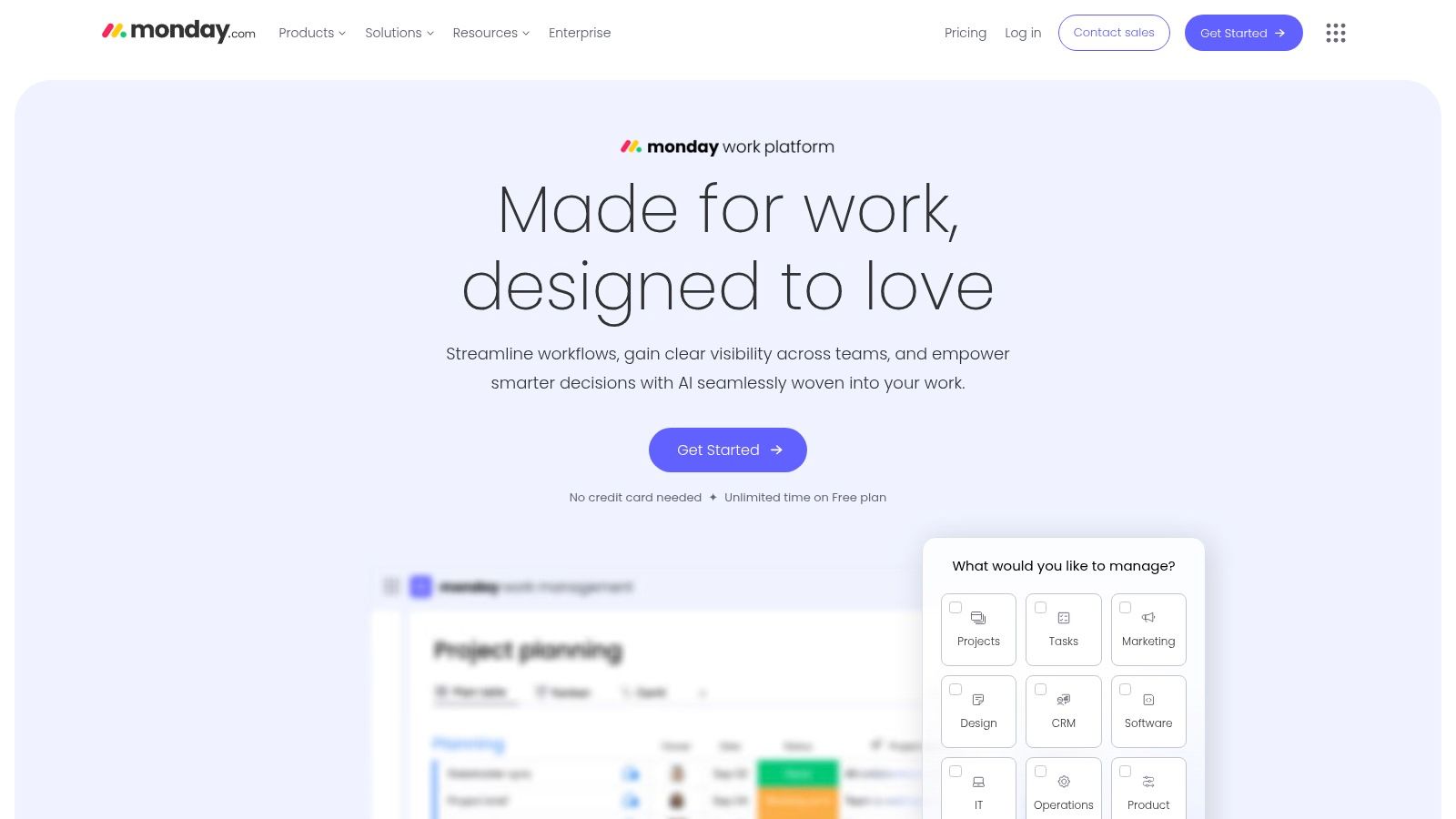
One of Monday.com's key strengths lies in its customizability. With over 200 templates catering to different use cases, users can quickly set up boards for specific project types. Don't see a perfect fit? No problem. The platform's no-code/low-code approach empowers users to build custom applications and workflows without needing extensive technical expertise. This flexibility extends to the various views offered, including Kanban, Gantt charts, calendar, and timeline views, allowing teams to visualize their projects in the way that best suits their needs. For instance, a marketing team might utilize Kanban for content creation workflows, while a software development team could leverage Gantt charts to track project milestones and dependencies.
Collaboration is seamlessly integrated through features like Workdocs for collaborative documentation and robust communication tools for updates and mentions. This fosters transparency and keeps everyone on the same page, regardless of their location or role. Furthermore, integrations with over 40 tools, such as Slack, Google Calendar, and Zapier, streamline workflows and reduce manual data entry. Customizable dashboards offer high-level project insights, allowing stakeholders to quickly grasp project status and identify potential roadblocks.
While Monday.com offers a wealth of features, it's essential to be aware of the potential drawbacks. Pricing can become complex and potentially expensive for larger teams. The platform's extensive customizability, while a strength, can also contribute to a steeper learning curve, particularly for administrators responsible for setting up and configuring workflows. Investing time in properly configuring the platform is crucial for maximizing its effectiveness. Additionally, some advanced features are reserved for higher-tier plans, which might necessitate careful consideration of budget and required functionalities.
Implementation Tips:
- Start with a template: Leverage the pre-built templates to get a head start on setting up your projects.
- Define clear roles and permissions: Ensure team members have appropriate access levels to relevant information and functionalities.
- Utilize automations: Automate repetitive tasks, such as notifications and status updates, to free up time for more strategic work.
- Explore integrations: Integrate with other tools to centralize your workflows and improve efficiency.
Monday.com earns its place on this list due to its visually appealing interface, extensive customizability, and robust feature set. While the pricing and learning curve might pose challenges for some, the platform's versatility and power make it a compelling choice for individuals and teams seeking a comprehensive project management planner. Explore Monday.com further at https://monday.com.
6. Jira: A Powerhouse for Project Management Planning
Jira, developed by Atlassian, stands as a robust project management planner, especially renowned within software development circles. While its origins lie in agile methodologies for tracking bugs and issues, Jira's versatile and customizable nature has led to its widespread adoption across diverse business teams. From marketing campaigns to research projects, Jira’s adaptable workflows, in-depth reporting, and powerful integration capabilities make it a compelling choice for complex project environments. Its particular strength lies in implementing Scrum and Kanban frameworks, making it a go-to solution for teams embracing agile project management.
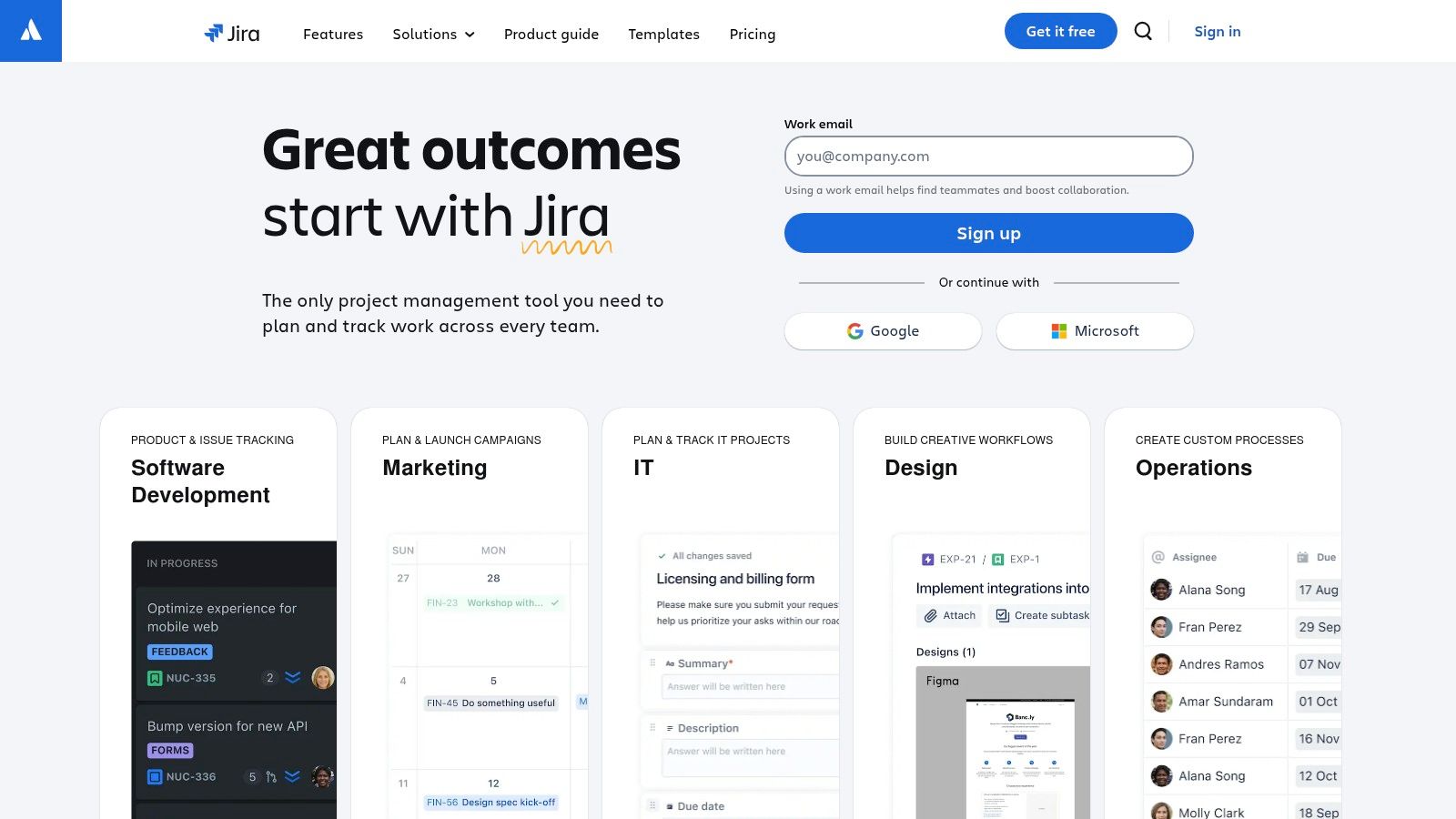
Jira's extensive feature set contributes significantly to its position as a leading project management planner. Agile boards for Scrum and Kanban provide visual workflows, enabling teams to track progress and manage sprints effectively. Its advanced workflow engine allows for customizable states and transitions, adapting to the specific needs of any project. Powerful issue tracking with custom fields and issue types ensures that every detail is captured and managed efficiently. Comprehensive reporting and roadmap visualization offer valuable insights into project health and progress, while its extensive API and integration ecosystem allow seamless connectivity with other essential tools. This makes it a particularly attractive option for businesses already invested in the Atlassian ecosystem.
Jira’s robust features make it ideal for various use cases. Software development teams can leverage its agile boards and issue tracking to manage sprints, track bugs, and collaborate effectively. Marketing teams can use it to plan campaigns, manage content creation workflows, and track progress towards goals. Even educational settings can benefit, with teachers using Jira to manage lesson plans, track student progress, and facilitate group projects. Business professionals, regardless of their industry, can utilize Jira for project planning, task management, and team collaboration.
Pricing and Technical Requirements:
Jira offers a range of pricing plans, from free options for small teams to enterprise-level solutions. Specific pricing details are available on the Atlassian website. Jira is a cloud-based solution, minimizing technical requirements. Users primarily interact with the platform through a web browser.
Comparison with Similar Tools:
While tools like Trello and Asana offer simpler project management solutions, Jira's power and customization capabilities distinguish it. Jira’s strength lies in managing complex projects with numerous interconnected tasks and dependencies, offering a level of control and detailed tracking that simpler tools often lack.
Implementation and Setup Tips:
While Jira is highly customizable, this flexibility can also lead to complexity. Start with a basic project and gradually introduce more advanced features as needed. Utilize Jira’s extensive documentation and online resources to learn best practices and optimize your workflows. Consider dedicated training for your team to maximize Jira’s potential.
Pros:
- Extremely powerful for software development projects
- Highly customizable for specific team processes
- Robust permissions and user management
- Strong integration with development tools
Cons:
- Complex user interface with a steep learning curve
- Can be overwhelming for non-technical teams
- Configuration and administration can be time-consuming
- More expensive than simpler alternatives
Website: https://www.atlassian.com/software/jira
Jira deserves its place in this list because it offers a comprehensive and powerful solution for project management planning. Its flexibility and customization options cater to a wide range of users, from small teams to large enterprises, across various industries. While its complexity might be a hurdle for some, the benefits it offers in terms of control, tracking, and integration make it a compelling choice for those managing complex projects.
7. ClickUp: Your All-in-One Project Management Planner
ClickUp is a powerful project management planner designed to streamline your workflow and consolidate all your work tools into a single platform. It offers a robust suite of features that cater to diverse project management needs, making it a suitable choice for entrepreneurs, teachers, students, and business professionals alike. Whether you're managing a complex marketing campaign, coordinating a classroom project, organizing your study schedule, or overseeing a large team, ClickUp aims to be the central hub for all your work-related activities. Its philosophy revolves around customization and flexibility, empowering users to tailor the platform to their specific requirements.
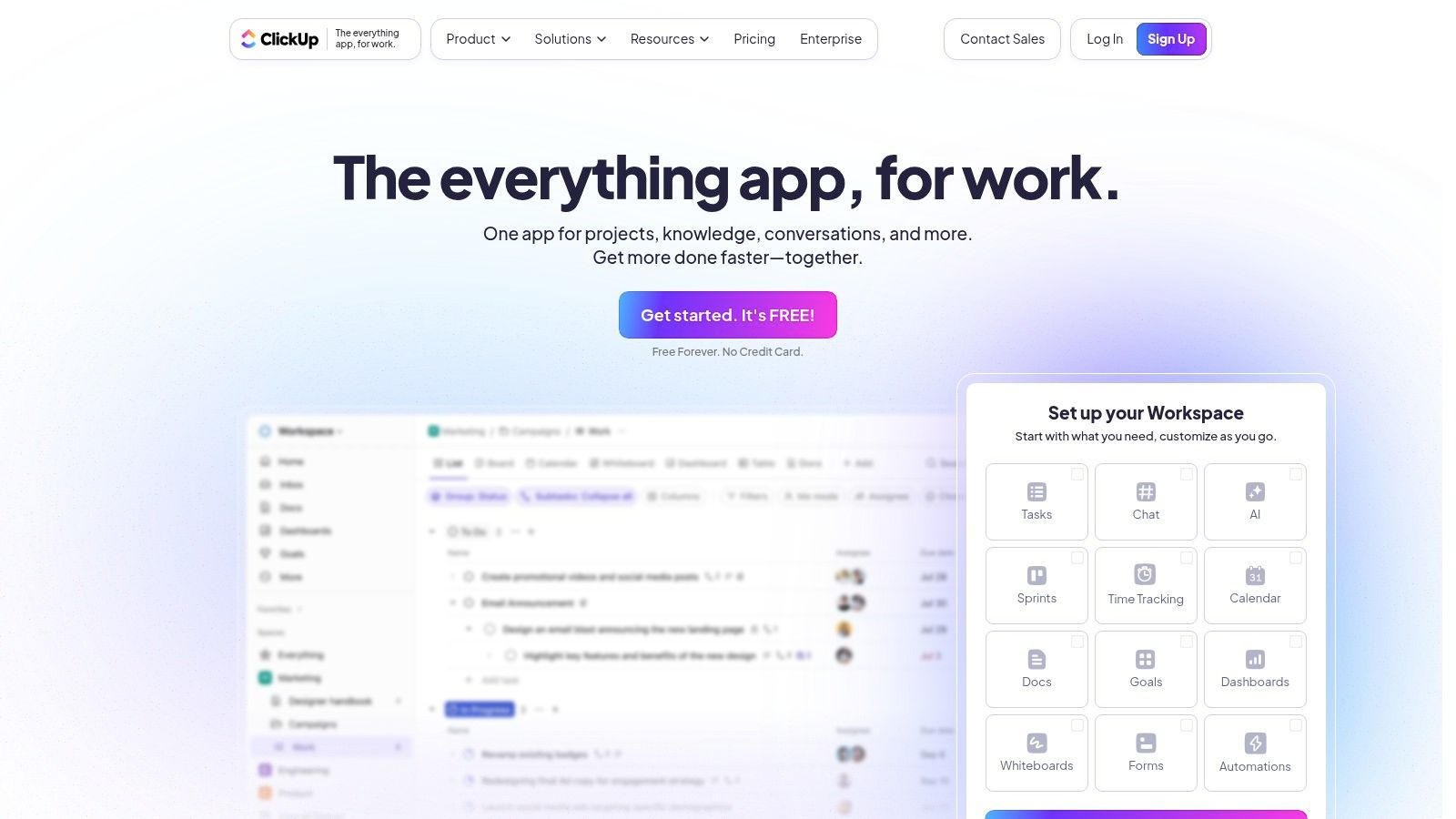
Features and Benefits:
ClickUp offers a wide range of features that contribute to its versatility as a project management planner:
- Multiple View Options: Visualize your projects in various formats, including list, board (Kanban), calendar, Gantt chart, and more. This flexibility allows you to choose the view that best suits your project and working style. For example, teachers might prefer a list view for grading assignments, while students can use a Kanban board to track their study progress.
- Document Collaboration: Collaborate on documents in real-time with your team, eliminating the need for constant file sharing and version control. This feature is especially useful for business professionals working on proposals or reports.
- Customizable Workflows: Tailor statuses, fields, and relationships to match your specific project requirements. This level of customization makes ClickUp adaptable to various project methodologies, from Agile to Waterfall.
- Goals & OKR Tracking: Set, track, and measure progress towards your goals and Objectives and Key Results (OKRs). This feature is beneficial for entrepreneurs and business professionals who need to monitor performance and ensure alignment with strategic objectives.
- Time Management: Utilize built-in time tracking, estimation, and reporting tools to gain insights into project timelines and resource allocation. This is crucial for efficient project management across all user groups.
Pros:
- Comprehensive Solution: Replaces multiple tools, streamlining your workflow and reducing software costs.
- Highly Customizable: Adapts to different team needs and project types.
- Generous Free Plan: Provides access to many core features, making it a cost-effective option for individuals and small teams.
- Continuous Improvement: Regular updates and new features based on user feedback demonstrate a commitment to enhancing the platform.
Cons:
- Overwhelming Feature Set: The sheer number of options and settings can be overwhelming for new users.
- Complex Interface: The interface can feel busy and complex, requiring a learning curve.
- Performance Issues: Some users have reported performance issues with larger projects or datasets.
- Mobile App Limitations: The mobile experience is not as robust as the desktop version.
Pricing and Technical Requirements:
ClickUp offers a free plan with unlimited tasks and members. Paid plans start at $5 per user per month and unlock additional features like increased storage, advanced reporting, and guest permissions. ClickUp is a cloud-based platform accessible through a web browser or dedicated mobile apps for iOS and Android.
Comparison with Similar Tools:
ClickUp competes with other project management tools like Asana, Trello, and Monday.com. While these alternatives offer similar functionalities, ClickUp differentiates itself through its extensive customization options and all-in-one approach.
Implementation Tips:
- Start Small: Begin with a simple project to familiarize yourself with the interface and core features.
- Utilize Templates: ClickUp offers pre-built templates for various project types, which can save you time and effort during setup.
- Customize Gradually: Avoid overwhelming yourself by customizing only the essential features initially.
- Explore Tutorials and Resources: ClickUp provides extensive documentation and tutorials to help you master the platform.
Why ClickUp Deserves Its Place:
ClickUp earns its spot on this list because it provides a powerful and flexible project management solution suitable for a diverse range of users. Its comprehensive feature set, customization options, and generous free plan make it a valuable tool for anyone looking to improve their productivity and streamline their workflow. While the interface can be initially daunting, the potential benefits of mastering ClickUp make it a worthwhile investment for individuals and teams seeking a centralized project management planner. Visit ClickUp
8. Passion Planner
For those seeking a tangible, distraction-free approach to project management, the Passion Planner offers a compelling alternative to digital solutions. This physical, paper-based planner helps individuals and teams alike set goals, map out projects, and monitor progress in a structured yet flexible way. It's designed to integrate both personal and professional commitments, making it a valuable tool for achieving a work-life balance. This project management planner stands out due to its focus on mindful planning and reflection, encouraging users to connect their daily actions with their long-term aspirations.
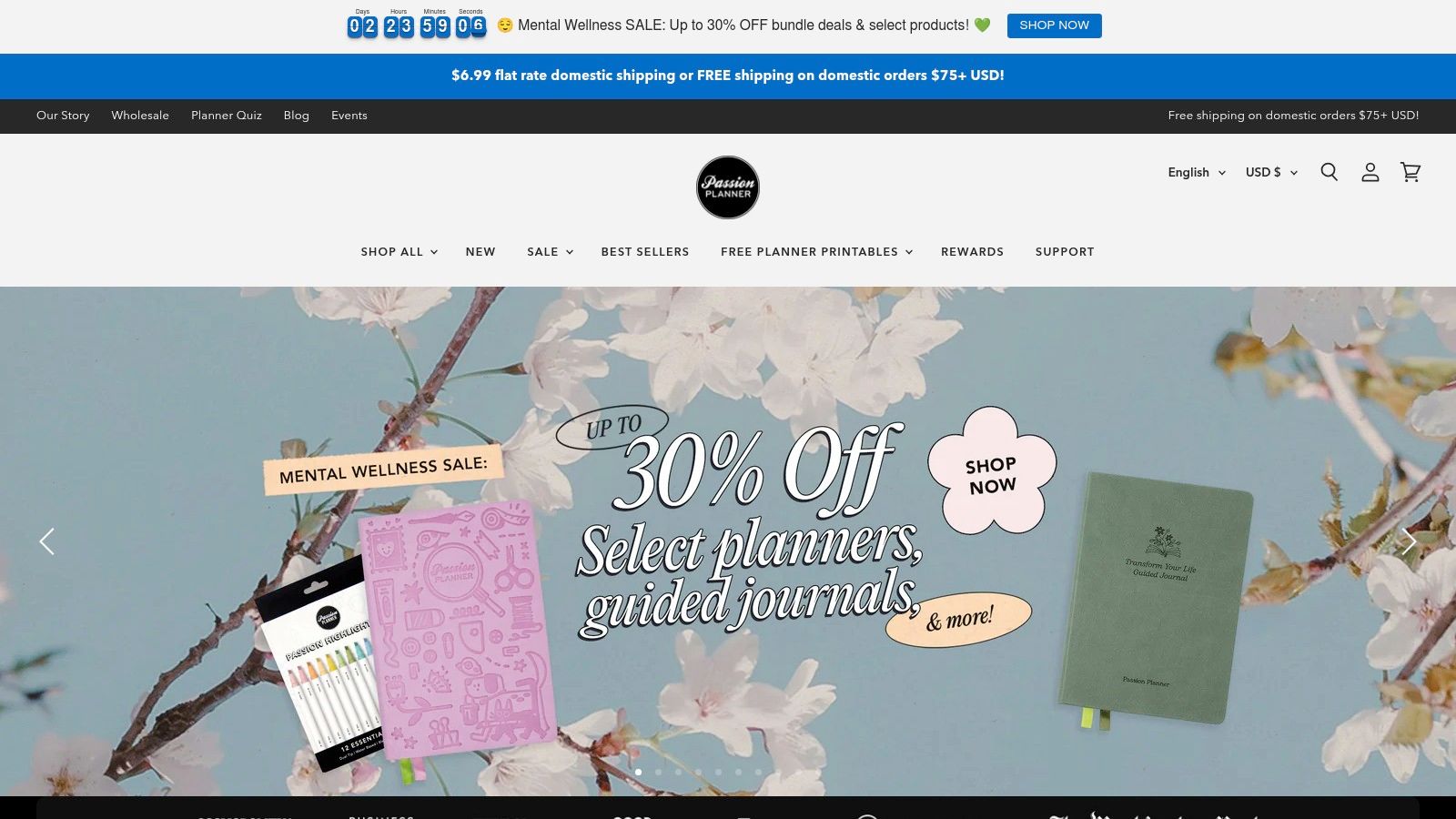
The Passion Planner provides a framework for goal-setting with dedicated spaces for annual, monthly, and weekly goals. Its weekly layout incorporates hourly scheduling and to-do lists, enabling users to break down large projects into smaller, manageable tasks. Monthly reflection and review sections facilitate progress tracking and encourage course correction when needed. Furthermore, the inclusion of space for mind maps and creative planning allows for brainstorming and visual organization of ideas. This feature can be particularly useful for entrepreneurs developing new business strategies or teachers crafting lesson plans. Students can utilize the planner to manage their academic workload, extracurricular activities, and personal goals. Business professionals can leverage the planner to organize projects, track deadlines, and manage their daily schedules effectively.
Unlike subscription-based digital tools, the Passion Planner is a one-time purchase. While undated versions offer maximum flexibility, dated planners provide a structured timeframe for specific projects. The act of physically writing down plans and tasks has been shown to improve retention and commitment, offering a distinct advantage over digital entries.
Pros:
- Tangible, offline experience: Eliminates digital distractions and promotes focused planning.
- Holistic approach: Combines project management with personal development.
- Cost-effective: One-time purchase versus recurring subscription fees.
- Improved retention: Handwriting fosters better memory and commitment to goals.
Cons:
- Limited space: Less capacity for detailed information compared to digital solutions.
- Difficult for collaboration: Sharing and collaborating with remote teams can be challenging.
- No automated reminders: Requires manual tracking of deadlines and appointments.
- Risk of loss: Physical damage or misplacement can result in data loss.
Website: https://passionplanner.com
Implementation Tips:
- Start with your Passion Roadmap: Before filling in specific dates and tasks, take time to define your long-term goals and passions. The Passion Roadmap section of the planner guides you through this process.
- Break down large projects: Utilize the monthly and weekly sections to deconstruct large projects into actionable steps.
- Schedule regular review sessions: Dedicate time each week or month to review your progress and make necessary adjustments.
- Personalize your planner: Use colored pens, stickers, and other visual aids to make the planner your own and enhance your engagement with it.
The Passion Planner excels as a project management planner for individuals who value a hands-on, reflective approach. Its focus on integrating personal and professional goals makes it a powerful tool for achieving a balanced and fulfilling life. While it may not offer the collaborative features of digital platforms, its tangible nature and focus on mindful planning make it a worthy contender in the realm of project management tools.
Project Management Planner Tools Comparison
| Product | Core Features ✨ | User Experience ★ | Value Proposition 💰 | Target Audience 👥 | Unique Selling Points 🏆 |
|---|---|---|---|---|---|
| Boss Personal Planner 🏆 | Digital & physical formats, habit tracking, goal & task integration | Easy-to-use, scientifically backed ★★★★☆ | Affordable with promos & bundles 💰💰 | Entrepreneurs, students, teachers, professionals 👥 | Versatile hybrid system, proven productivity methods, flexible templates ✨ |
| Asana | Task management, timelines, automation | Intuitive, customizable ★★★★☆ | Free tier for small teams, paid plans vary 💰 | Teams of all sizes, cross-functional 👥 | Flexible views, 200+ integrations, workflow automation ✨ |
| Microsoft Project | Advanced scheduling, resource mgmt | Powerful but complex ★★★☆☆ | Expensive, enterprise-focused 💰💰💰 | Project managers, large organizations 👥 | Industry standard, robust reporting, deep MS ecosystem integration |
| Trello | Kanban boards, Power-Ups, automation | Very user-friendly ★★★★★ | Generous free plan, paid upgrades 💰 | Individuals, small teams 👥 | Visual simplicity, drag-and-drop, approachable for beginners ✨ |
| Monday.com | Custom workflows, multiple views | Visual, highly customizable ★★★★☆ | Pricing varies, can be costly 💰💰 | Teams needing workflow flexibility 👥 | No/low-code apps, colorful interface, detailed dashboards ✨ |
| Jira | Agile boards, issue tracking, reporting | Powerful but steep learning ★★★☆☆ | Higher price, complex setup 💰💰 | Software development teams 👥 | Scrum/Kanban focus, extensive integrations, deep customization ✨ |
| ClickUp | Multi-view, docs, goal tracking | Feature-rich, customizable ★★★★☆ | Generous free plan, paid tiers 💰 | Diverse teams, all industries 👥 | All-in-one platform, frequent updates, customizable workflows ✨ |
| Passion Planner | Goal frameworks, weekly scheduling | Tangible, distraction-free ★★★☆☆ | One-time purchase 💰 | Individuals preferring paper planning 👥 | Offline, handwriting benefits, personal development focus ✨ |
Choosing the Perfect Project Management Planner
Finding the right project management planner can feel overwhelming with so many options available. From the robust features of platforms like Asana, Microsoft Project, Trello, Monday.com, Jira, and ClickUp, to the tactile experience of physical planners like the Passion Planner, each tool offers unique strengths for different project management styles. We've explored eight diverse options in this listicle, highlighting key features and functionalities to help you navigate this landscape. Remember, the most important takeaways are to consider your team size, project complexity, budget, and desired features when selecting a planner.
For teams, efficient information sharing is crucial for successful project execution. A centralized repository of information can significantly improve collaboration and reduce confusion. For another perspective on streamlining information access and management, especially for teams, explore the benefits of using a knowledge base software solution, as outlined in Top Knowledge Base Software in 2025 | Boost Your Team’s Efficiency from FlowGent AI.
Whether you're an entrepreneur juggling multiple ventures, a teacher managing classroom projects, a student organizing assignments, or a business professional leading complex initiatives, the right project management planner is an invaluable asset. The ideal tool empowers you to stay organized, prioritize tasks effectively, and ultimately achieve your project goals with greater efficiency.
If you're looking for a powerful yet personalized planning solution, consider the Boss Personal Planner. Designed to help you manage both personal and professional projects with equal effectiveness, the Boss Personal Planner provides the structure and flexibility needed to conquer your goals and enhance your productivity. Get your Boss Personal Planner today and take control of your schedule!
